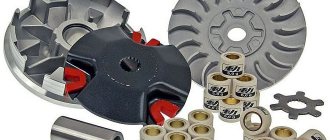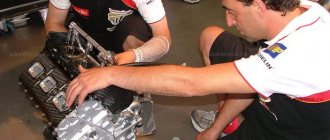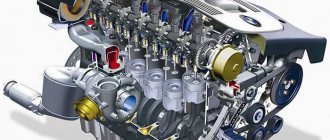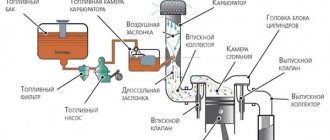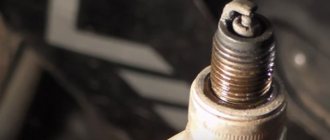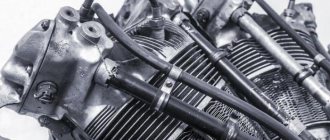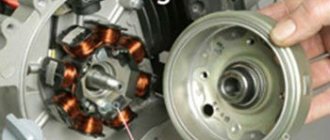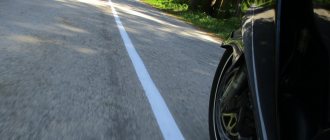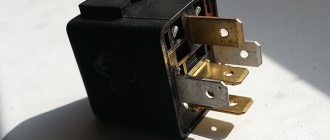A motorcycle clutch is a serious unit that transmits torque from the engine to the rear wheel drive (gearbox). In part, it is classified as consumables, since it needs to be changed regularly. On the other hand, this mechanism requires precise tuning and the ability to control the bike, which can significantly extend its service life.
000_moto_0511_076
Let experienced motorcyclists and motor repair professionals not be surprised that I write about well-known truths.
It is also useful for experts to refresh their memory, but the main thing is to protect beginners from misunderstanding the processes occurring with a motorcycle, and as a result, from costly mistakes. Let experienced motorcyclists and motor repair professionals not be surprised that I write about well-known truths. It is also useful for experts to refresh their memory, but the main thing is to protect beginners from misunderstanding the processes occurring with a motorcycle, and as a result, from costly mistakes.
The abundance of design variations on the theme of friction between a pair of disks sometimes causes confusion in the minds of those who are just discovering the principles of operation of this unit. The purpose of our material is to protect your heads from this strange condition, and your clutch from its consequences. A properly functioning clutch gives the driver the opportunity to accurately dose the engine torque when transmitting it to the gearbox shaft and further to the wheels. On road motorcycles this is important at the start, when turning on a narrow road and, especially, when driving in city traffic jams. On enduro, the work of the clutch is absolutely invaluable when driving through difficult obstacles.
Clutch wear may be indicated by noise in the crankcase, tight lever squeezing, or vibrations. But none of these symptoms alone is a death sentence. For example, noise may be normal for a given model of motorcycle; moreover, as a rule, it is produced by gearbox gears rotating without load. Vibrations at the moment of start are more common on completely new motorcycles, when the clutch discs have not yet gotten used to it.
A more serious symptom is clutch slipping: the lever is released, but there is no rigid connection between the engine and the wheels. The motorcycle can move, but as soon as you add gas, the engine speed begins to increase faster than the speed, as if instead of a manual gearbox you have a hydromechanical “automatic”. In the initial stage, slipping appears only in higher gears, but after half a day of active driving the clutch comes to an end. Therefore, at the first sign of slipping, you need to stop. If the drive is cable, check the free play and ease of movement of the cable. Is the cable tension when the lever is released? Tighten the adjusting nut to loosen the cable. It is better to check the free play of the lever on the drive shaft (1-2 mm at the end of the lever) - this way we will at the same time make sure that the cable is not overtightened and does not get stuck in the sheath. The cable cannot go out of adjustment on its own; there must be some reason. If it gets caught on something, such as in the woods, the shell stop may pop out of its recess, creating tension. Therefore, pay attention to how the cable is installed.
Couple-uncouple
Transmission. Part 2. Clutch and quickshifter
Text: Artem 'S1LvER' Terekhov
Any motorcycle must be able to disconnect the crankshaft drive from the rear wheel so that the engine can run when the bike is stationary. Despite this obvious statement, imagine this possibility did not always exist.
Many early motorcycles used direct drive via a belt and pulleys on the crankshaft and rear wheel that could not be separated. This drive really worked, but some problems arose during its operation. For example, to stop at an intersection, you had to turn off the engine. And in this case, it was possible to start the bike only from the pusher, which is clearly not the best starting option. The clutch mechanism was designed to ensure that the running engine is decoupled from driving the rear wheel. The second function, no less important, is the ability to select gear ratios on machines that are equipped with a gearbox. Let's see how this mechanism works. Clutch principle Clutch operation is based on friction. In its simplest form, the clutch consists of two discs, one of which is located on the crankshaft journal, and the second is connected through some drive mechanism (chain, belt, gears) to the rear wheel and is pressed against the first disc. If there is a small gap between the disks, the engine runs while the second disk remains motionless. If you connect the disks to each other, the rotation of the crankshaft due to friction will be transmitted to the second disk, and since it is connected to the rear wheel, it will also rotate. So the power supply from the engine to the wheel can be switched on or off as needed. The vast majority of modern production bikes use a manually operated clutch from a lever located on the handlebars. The exception is scooters that use an automatic centrifugal clutch, the operating mode of which depends on engine speed. Our article will focus specifically on the clutch that is used on motorcycles (unfortunately, the format of the article does not allow us to laugh enough at funny stories about scooter riders who switched to motorcycles and try to “brake” with the clutch). How the clutch works The entire clutch assembly is installed on the input shaft of the gearbox (read about the structure of this device in our article). housing or outer drum is mounted on a bearing and can rotate freely and independently of the shaft. The outer clutch drum is directly connected through the forward gear to the crankshaft (although there are also designs in which the clutch is mounted directly on the crankshaft journal; this arrangement is common on motorcycles made by BMW and Moto Guzzi), so that when the crankshaft rotates, it also rotates. The central part of the clutch, or inner drum (hub), is smaller and is located inside the outer drum. It is installed on the input shaft of the gearbox and is secured against rotation by splines, so that when the inner drum rotates, the input shaft also rotates.
Section of a multi-plate clutch in an oil bath, Yamaha R6 2008
The clutch discs are located in the space between the outer and inner drums. Two types of discs are used: smooth and friction. They are arranged alternately, and the exact number of discs depends on the type of clutch and the machine on which it is used. On the outer circumference of the friction discs there are rectangular splines that are installed in the grooves of the outer clutch drum. On the inner circumference of the smooth discs, teeth are cut, which are installed in the grooves of the inner clutch drum. In the normal position (when the bike is in motion), the friction and smooth plates are held in direct contact by springs acting on a plate called the pressure plate . When the crankshaft and outer clutch drum rotate, due to the friction that occurs between the plates, the inner clutch drum, and therefore the transmission input shaft, also rotates. When the rider squeezes the clutch lever, the cable or hydraulic mechanism, counteracting the force of the springs, pushes the pressure plate away from the pack of smooth and friction plates, causing the discs to no longer touch. By eliminating direct contact between the discs, friction is reduced, allowing the outer drum to rotate freely relative to the inner drum. As the rider releases the clutch lever, the discs are pressed against each other again, and gradually the rotation of the outer clutch drum due to friction begins to be transferred to the inner drum, thus gradually transmitting torque to the gearbox and further to the rear wheel; this eliminates the possibility of stopping or jerking (of course, if you do everything correctly and release the clutch smoothly). The ability of the clutch to transmit torque depends on many factors: the number and diameter of the discs, the force of the springs compressing them, and the coefficient of friction between the discs. All other things being equal, smaller machines require fewer disks than large, powerful machines. Likewise, if the torque is the same, then by increasing the diameter of the disks their number can be reduced. Friction discs (who would have thought?) have friction material applied to them, while smooth discs are made of steel.
2007 Honda CBR1000RR Clutch Components
Design matters When choosing the type of clutch to be installed on a particular motorcycle, several determining factors influence the designer's decision. First, let's look at the number of disks. A multi-plate clutch uses more than one set of smooth and friction discs, usually seven or eight, and sometimes nine friction discs are used. There are always one fewer smooth discs compared to friction discs, since the disc package is always limited on both sides by friction discs. On most monoblock engines (that is, those in which all transmission components are located within the engine crankcase) with a transverse crankshaft in the frame, a multi-plate clutch is used. The reason for this is the small clutch diameter. A multi-disc clutch is also much lighter than a single-disc clutch, although it has a larger friction surface and strength. Single- or double-plate clutches are used on motorcycles with a longitudinal crankshaft in the frame (for example, Moto Guzzi bikes with a V-twin, the cylinders of which are located across the frame). The clutch is mounted on the rear journal of the crankshaft and has a separate housing between the engine and gearbox. Because of this arrangement, the clutch does not need to be compact, and with large diameters only one or two discs are needed. The next question that designers decide is to use a dry clutch or one operating in an oil bath.
Ducati 749 dry clutch on display (covered in stock, of course)
It may seem strange that a mechanism whose principle is based on friction should operate in oil; but there are several important reasons for this. The oil acts as a heat dissipator to prevent the clutch from burning. In addition, it serves as a lubricant for the bushings or bearings on which the outer clutch drum rotates, and also facilitates the movement of splines and disc teeth. An additional “bonus” of an oil bath clutch is that to ensure lubrication of the front gear, you do not need to seal the clutch in a separate chamber. You can’t go against physics - naturally, the friction provided between the clutch discs operating in an oil bath is lower than the friction between the dry clutch discs. Therefore, large-diameter disks or a larger number of them are required (or perhaps both), which leads to increased dimensions.
Suzuki RGV250 equipped with dry clutch
The same RGV250, but with an oil bath clutch
This is why dry clutches are mainly used on sports bikes. High efficiency and low weight (no need to pour oil) are an integral part of a dry clutch. However, the same as a small resource. Most racing machines are equipped with a dry clutch, as are almost all civilian Ducati sportbikes (except for the 848, but there is a separate one for it). Japanese manufacturers mainly use oil bath clutches. From a practical point of view, a “wet” clutch looks preferable - a much longer service life and less tendency to overheat. On the other hand, if the goal is maximum performance in a race, then the choice will be in favor of a dry clutch.
Nothing is broken here, this chirping sound is the sound of a working dry Ducati clutch
Another point that the designer must decide is how the force from the lever will be transmitted to the clutch drive mechanism. Most often, a cable is chosen for this purpose, otherwise a mechanical clutch drive . Cables are subject to stretching and wear, and require adjustment and lubrication, but are easy to maintain and repair. The mechanical drive is simple - the cable acts on the clutch through a drive mechanism located inside the clutch cover or on the opposite side of the crankcase, while the mechanism acts on a long pusher passing through the input shaft of the gearbox. The hydraulic clutch drive mechanism is used mainly on large-volume machines. It costs much more and requires careful maintenance, but the shortcomings are more than offset by the smoothness and ease of its operation. The hydraulic drive operates on the same principle as the front brake system (we will also talk about brake systems in due course): when the lever presses on the master cylinder plunger, it acts on the hydraulic fluid and forces it into the hose. The fluid then pushes the piston of the working cylinder, which acts on a pushrod located inside the input shaft. Other than regularly checking the fluid level, the hydraulic system requires little to no maintenance, although fluid and seals must be replaced periodically to keep it functioning properly. Also, the design of any hydraulic system implies that the fluid is prone to absorbing water and becoming saturated with air (in short, servicing the hydraulic clutch is similar in care to servicing the brake system). With that out of the way, let's move on to more modern and high-tech stuff. I think that while reading reviews of modern motorcycles, you have repeatedly come across the phrase “slipper clutch.” As a rule, the presence of it on the motorcycle being tested delights the tester, which he immediately reports. However, no one really explains how this thing works. Let's start with this. Slippery type The slipper mechanism in the clutch (hereinafter referred to as PS for simplicity) is a development aimed at high-performance motorcycles. The main goal for the PS is to limit the reverse torque that appears when braking the engine from high speed or when changing to lower gears. For the first time, the PS was used on a drag bike of the 70s under the name Hogslayer - a non-trivial clutch for that time allowed the “Pig Killer” to accelerate to 290 km/h without slipping or overheating (in addition, two 880 cc injection engines contributed to this maximum speed from Norton, but that's a completely different story...). Among modern production motorcycles, the slipper clutch has also found its place - mainly, it is equipped with sportbikes, as well as charged factory street bikes.
Slipper clutch for Ducati 999 from FBF
Now let’s take a closer look at why PS is used in general. When the gas is opened, the rear wheel is driven through the clutch. When the throttle is closed and the bike continues to move at a speed higher than the set limit corresponding to the current throttle opening, the rear wheel is still turning the engine shaft through the clutch; but because the engine offers a lot of drag (due to compression, especially at high speeds and lower gears), it is possible to reach a point where the drag, or back-torque, of the engine exceeds the rear tire's coefficient of adhesion. The result of this is a locked rear wheel. This outcome is especially likely in rainy conditions, because... in the rain, the coefficient of adhesion between the tire and the road is greatly reduced, and the weight redistribution that occurs during sudden braking reduces the load on the rear axle. PS is installed in order to eliminate the possibility of wheel locking due to clutch slipping when changing the direction of torque transmission. However, the PS does not disengage the clutch completely, and the engine braking effect remains. Different manufacturers approach the design of the clutch in different ways, but most often slippage is ensured by the following mechanism: the inner clutch drum is located on a series of ratchet stops with an inclined surface. When the direction of torque transmission changes, the inner clutch drum moves on the ratchet stops, thereby retracting the pressure plate and relieving pressure on the discs. This approach was commercially tested for the first time on the Kawasaki ZXR 750.
2007 Kawasaki ZX-6R Slipper Clutch - Standard
Aprilia engineers took a more complex and technological path when designing the RSV Mille clutch. To move the inner clutch drum, a servomotor is used, which is controlled by a vacuum supplied from the engine intake manifold. When the throttle is closed, the increased vacuum in the manifold creates a vacuum in the air line of the servomotor, which shifts the inner clutch drum and relieves pressure on the discs. This approach is no longer used anywhere except RSV; manufacturers prefer a simpler option, tested on the ZXR 750 (each company tries to bring something different to the PS design, but the general principle remains very similar to the Kawasaki version). Whatever one may say, despite its simplicity, the slipping mechanism in the clutch is a very, very useful thing. If your motorcycle is not equipped with PS, do not despair, it is likely that a tuning kit for it exists in nature, you just need to look for it. Quickshifter Finally, we got to the long-awaited topic - the Translogic quickshifter systems, also known as BMW Quickshifter. Contrary to the sensational statements of the German company about the new super technology, such systems of “quick gear shifting without the rider releasing the clutch”, produced by some tuning companies, the most famous of which are Translogic and Dynojet, have long been used by participants in the World Superbike, Supermoto/MX and even go-karts It's just that BMW was the first company to decide to install this system in some production bikes.
The advantage of the mechanism is inherent in its very name: “quick” - “fast”, “shift” - “shift, displacement, switching”. That is, “quickshifter” literally translates as “quick switch”. How quickly do the gears change, you ask? The answer can be found in the example given on the official Translogic page. “The most professional motorcycle racer takes at least 340 milliseconds to change gear, while Translogic systems require 48 to 150 milliseconds.” Impressive, isn't it? Another technology that came down from the Olympus of big-time motorsport and became accessible to “mere mortal” motorcyclists.
DynoJet QuickShifter Kit
Now let’s look at the “quick click” device. The key elements of the entire mechanism: a pressure sensor (monitors the pressure on the gear shift foot; simply put, it determines whether the rider presses it or not) and a quickshifter rod (if the standard one does not fit). Some manufacturers (for example, Dynojet) also offer a quickshifter on/off button that can be mounted on the steering wheel. The sensor is connected to an external ignition control module (for example, Power Commander). When the rider puts pressure on the gear shift paw, the sensor sends a signal to the ignition control module, after which it instructs the ECU to temporarily turn off the ignition (for a few tens of milliseconds). When the engine is turned off, switching occurs - without releasing the gas or squeezing the clutch. In the case of BMW motorcycles, there is no need to buy an ignition control unit - the quickshifter is connected to the original “brains”, nothing needs to be adjusted or installed. Usually a quickshifter is installed when they want to improve the acceleration dynamics of the device, but nothing prevents you from shifting down in the same way when braking.
*****
I hope that by reading this article you have made some further progress in understanding what a motorcycle is. However, a lot of ironclad questions have not yet been solved, so stay tuned, there are many interesting topics for discussion ahead!
001_moto_0511_076
Proper cable adjustment is the key to long clutch life.
It takes seconds, no tool is needed, but it lasts a long time. Proper cable adjustment is the key to long clutch life. It takes seconds, no tool is needed, but it lasts a long time.
If after adjustment the signs of slipping disappear, consider yourself lucky: the motorcycle can be ridden. But this rarely happens. If the clutch slips even when the cable is adjusted correctly, then it’s time to change it. Slowly, preferably in low gears, head to the repair site, trying to keep slipping to a minimum. Many modern bikes use a hydraulic clutch drive. It does not involve any adjustments and, in principle, cannot cause the clutch to slip. Therefore, slipping on such motorcycles is almost always a sign of serious wear on the unit.
There is another picture - the clutch “leads”: the lever is squeezed all the way, and the motorcycle tries to move forward. Gears are difficult to shift, and neutral is almost impossible to catch. In cold weather this is normal; When the frozen oil warms up, everything will return to normal. But if the motorcycle has spent the winter in “hibernation”, the discs can “stick” tightly to each other. To separate them, sometimes you have to drive several kilometers (it is advisable to play with the gas and brake, squeezing the left lever all the way). In especially severe cases, the discs are seized so that it is impossible to even move. Then the following scheme works: two friends push your motorcycle back and forth, and you, as the owner, sit on it, loading the rear wheel and squeezing the clutch lever. On the third or fourth piston the discs usually turn. Otherwise you will have to disassemble the assembly.
If the clutch begins to “drive” during operation, we again turn to the cable adjustments. Perhaps its free play is too big. Reduce it, but remember that a slight play at the end of the lever should remain. The hydraulic drive can also become a problem, since air in the system or a torn cuff will not allow you to fully press the clutch. But if everything is fine with the cable and hydraulics, you will have to look for the fault inside.
On domestic motorcycles, it happened that unevenly adjusted clutch springs distorted the disk pack and they continued to rub on one side, preventing the drive from completely disengaging. This is not difficult to determine: we look at how the discs move in the basket when the lever is pressed. If it is uneven, rotate one or more screws securing the springs. In modern systems this is basically impossible (the screws are tightened all the way), and it is only extremely rare that the disks themselves become bent.
How does a motorcycle clutch work?
Whether we use our foot or our hand to power it, we all know that when we engage the clutch, our motorcycle engine is able to transfer power to the transmission and ultimately send it to the rear wheel.
Perhaps for many people, even those who consider themselves bikers and own a motorcycle, everything that happens inside the oblong metal box installed on the side of the engine as the motorcycle moves remains a mystery. Today there will be one less mystery, and together we will study the basics of the mechanism and see what parts it consists of, using the example of a 1933 Harley-Davidson VL motorcycle. Why did we choose this particular model and not some Ural M-72? We just think that Harley is really extremely beautiful, and the clutch principle of all motorcycles (almost all) has not changed over the past 100 years.
Harley-Davison VL from the 1930s
However, there is still a difference in clutch control: the American car of the 30s uses a clutch mechanism controlled by the foot, and not the modern analogue, transferred to the steering wheel, otherwise the principles have not changed.
002_moto_0511_076
Long-term driving with a heavily slipping clutch can kill the engine of your motorcycle: particles of burnt friction discs will inevitably get into the oil, and with it into the precision joints of the bearings, connecting rods, and pistons.
Against the background of the drain plug you can see how large the pieces of friction clutches can be. They can clog the lubrication system channels very quickly. Then you will have to disassemble the entire engine. Long-term driving with a heavily slipping clutch can kill the engine of your motorcycle: particles of burnt friction discs will inevitably get into the oil, and with it into the precision joints of the bearings, connecting rods, and pistons. Against the background of the drain plug you can see how large the pieces of friction clutches can be. They can clog the lubrication system channels very quickly. Then you will have to disassemble the entire engine.
When opening the crankcase of the power unit for diagnostics and repair (replacement) of the clutch, you need to imagine what you are getting into. Firstly, most likely (especially on an older motorcycle) you will need a new crankcase cover gasket (the old one delaminates and breaks). Secondly, on some motorcycles, to access the body, you will have to remove the exhaust pipe of the muffler (it makes it difficult to pull out the cover), and this is not always easy and may lead to the need to look for the pipe gasket, studs, nuts, etc.. The problem with unexpectedly Scarce spare parts also apply to the fastening of the cover - on some motorcycles the screws are disposable. Thirdly, if the clutch is slipping, flushing the engine and changing the oil and filter is a mandatory procedure. Finally, you will need a good tool and a clutch kit itself, preferably a complete one (clutches, steel discs and springs). Let me note that field repair involves much fewer conventions. Thus, the cover gasket can be cut from any flat material of suitable thickness - from cardboard to linoleum, and installing washers under sagging springs will help to temporarily tighten the disks.
Doesn't that stop you? Then we will assume that the preparation has been completed: the clutch cover has been removed, the gasket is torn, and the disposable screws are neatly lying around, awaiting reuse. It's okay, we'll worry about that after we repair the clutch itself. Perhaps in another article.
We unscrew the screws (often with internal hexagons) securing the clutch springs and the pressure disk, but we are in no hurry to remove the disks themselves. It is necessary to note the peculiarities of the location of the disks in the basket. Multi-disc systems suffer from increased noise when the clutch is fully depressed and when the gearbox is in neutral. The noise is created by the disc crowns lightly hitting the edges of the slots in the clutch basket. The noise could be reduced by reducing the gap between the rims and the basket, but then the risk of the disks jamming when heated increases. Therefore, usually one friction disk, usually the upper one, is placed in special grooves that are slightly smaller in width. This disk practically does not move along the grooves and, accordingly, does not jam, but at the same time, being pressed against the other disks, it restrains their looseness inside the basket. Sometimes for the same purpose they make one crown narrower than the others on all the disks, and a narrower groove on the basket. It happens that some clutches have a smaller working surface width or other differences. It’s impossible to list them all, and that’s why when disassembling a new unit for the first time, pay attention to the nuances. After removing the disks, it is easy to determine what happened to them. Clutches (those with paper, plastic or cork sectors around the entire circumference) are usually brownish or greenish in color. Blackening and a burning smell are a death sentence for them. The same problem as for intermediate metal discs is deformation or tarnishing.
It is quite difficult to wear out the clutch while driving the motorcycle correctly. As a rule, this takes about 40 thousand km. But it also happens that a worn clutch does not smell like burning. It’s just that the overall thickness of the disk package decreases, as does the friction between them. With high mileage of the motorcycle, the basket itself wears out. A groove appears on the edges of its longitudinal slots, impeding the movement of the discs and the smooth release of the clutch. A shallow hole can be carefully leveled with a file, although, of course, this is an extreme measure and it is better to replace the basket with a new one. (To unscrew the nut securing it, just put the gearbox in high gear, press the brake pedal with your foot, and pull the key with your hand. With a certain skill, neither special devices nor even an assistant are needed.)
Before installing new discs, be sure to saturate them with engine oil and carefully monitor the correct sequence of their installation in the basket. It is very important not to exceed the tightening torque of the clutch spring screws. It is small and the threads in the duralumin drum are easy to break.
Springs are another important element of the unit. For road motorcycles, springs that are not too stiff are used so that the hand does not get tired when frequently pressing the clutch. But if you are using the bike for racing, it is better to set it harder. After all, the clutch will actively work only once - during the start. By the way, racing clutch kits can only withstand two fast starts in a row. What can we say about ordinary road ones. Keep this in mind if you decide to participate in street drag racing.
All of the above applies to the most common type of clutch on motorcycles - multi-plate, in an oil bath. But there are others. Ducati, for example, is famous for its multi-disc dry clutch. Very noisy, it nevertheless creates less resistance to rotation. From time immemorial, BMW has been using a convenient, from the point of view of layout, dry single-plate automotive-type clutch on its boxer cars. A dry clutch does not like long slips and from this point of view is inferior to a “wet” one. But he also has a serious advantage - he absolutely does not care what kind of oil is poured into the engine. That is why it is not recommended to fill motorcycles with a conventional (wet) clutch with automotive oils with antifriction additives, as well as any friction modifiers and other automotive dietary supplements. Slipping will not be long in coming.
Finally, advice to novice motorcyclists: take the time to train your skills in operating the clutch lever. This is a vital governing body. You need to master the skill of a smooth start and be able to take off quickly, be able to turn around in a limited space and shift gears “down” during emergency braking. Without this, it is impossible to drive a motorcycle efficiently and get real pleasure from riding.
Motorcycle clutch basket
The last important clutch component, just like in a car, is the clutch basket, which, as the name suggests, connects the components of the clutch disc pack.
There are grooves on the inside of the clutch basket that coincide with the “keys” on the outer sides of the discs with friction compound. They secure the plates in the basket, but also allow the discs to move up and down, just like splines on the drive plate allow steel discs to move.
On the outside of the clutch basket are the teeth of a gear, which is usually connected to the engine by a chain or belt (this is not the chain that goes to the wheels, but a shorter equivalent). In this particular example, there are two gears on the clutch basket because it uses a double row chain to connect to the engine.
106_moto_0511_076
...and disengage the cable itself.
Sometimes it is convenient to press the lever on the steering wheel and place some kind of stop under the shutdown lever. It will allow you to remove the end of the sheath from the recess, and then easily remove the cable itself. ...and disengage the cable itself. Sometimes it is convenient to press the lever on the steering wheel and place some kind of stop under the shutdown lever. It will allow you to remove the end of the sheath from the recess, and then easily remove the cable itself.
Clutch pack
After the driven disk is installed on the plate pack, they are held together with spring-loaded bolts. The bolts pass through the clutch discs, screwed with three special nuts on the reverse side.
This design aligns the clutch elements and also allows the friction elements to move between the driven and pressure plates.
Clutch springs provide pressure and the resulting friction between friction-coated discs and steel plates, transferring torque from the engine to the transmission.
When the clutch is engaged (clutch pedal or lever released), the pressure generated by the springs is sufficient to hold the discs without moving. It is also important to note that the asbestos-coated discs are not attached to anything, so without this friction created by the release springs, the discs could spin against the steel, causing the clutch to slip and burn.
This leads to the following logical conclusion, which some inexperienced customizers, out of ignorance or neglect, do not pay attention to: if you increase the power/torque of the engine, you need to use stronger springs that will not allow the discs to slip past each other.
Also, as the friction-coated discs wear, the clutch pressure spring guide bolts can be tightened to restore downforce to the required values. The assembled unit is called a clutch disc pack.
112_moto_0511_076
On sale there are also separate sets of friction discs (pictured), and steel ones (they last longer), and springs (saving on them sometimes leads to the rapid failure of a new set of discs).
On sale there are also separate sets of friction discs (pictured), and steel ones (they last longer), and springs (saving on them sometimes leads to the rapid failure of a new set of discs).
A simple tutorial to help you ride a motorcycle.
Dear friend, are you going to learn how to ride a motorcycle? Right? This is probably why you went to a driving school, to gain initial skills in driving a motorcycle and at the same time learn the rules of the road, in order to subsequently obtain a driver’s license of category “A” or “A1”? But for some reason, do you also need additional knowledge, as well as accessible, simple explanations that will help you quickly and easily learn to ride a motorcycle? No problem. Our online publication offers you a small guide - “Step by step” with the help of which anyone can understand for themselves what they need to do in order to quickly learn how to operate a motorcycle.
A motorcycle, like a car, definitely attracts attention. Many of us would like to master it (its control) in our dreams, but as usual, we mistakenly believe in advance that driving a motorcycle is quite difficult and very dangerous. But this, my friends, is not at all like that, in fact, everything is quite simple, you just need to follow all precautions and, of course, the traffic rules, then the motorcycle itself will become no more dangerous for you than a car.
116_moto_0511_076
All that remains is to install the clutch release parts.
The main thing is that the cover should easily snap into place; you should not force it down - it would be easy to break the teeth on the clutch drive shaft. It doesn’t matter if the lever doesn’t get into the desired position; it’s easy to rearrange it on the splines. A shaft with a pair of chipped teeth can be temporarily used by simply turning it 180°. All that remains is to install the clutch release parts. The main thing is that the cover should easily snap into place; you should not push it down by force - it would be easy to break the teeth on the clutch drive shaft. It doesn’t matter if the lever doesn’t get into the desired position; it’s easy to rearrange it on the splines. A shaft with a pair of chipped teeth can be temporarily used by simply turning it 180°.
Friction force: diagnosing and changing the clutch
Anatomy of a Motorcycle Clutch: Here's How It Works
Automobile and motorcycle disc clutches operate on the same principle: the mechanism is based on the use of sliding friction to transmit torque to the drive wheels. Nevertheless, from the point of view of the implementation of the mechanism of action, motorcycle systems differ to a large extent from their automobile counterparts, at least in their size and lighter weight, as well as in a number of parameters.
See also: Vintage Review: 1947 Harley-Davidson UL Bobber
catalogue of articles
Today we will talk about the principle of operation of a motorcycle clutch. One way or another, the principle of operation of a motorcycle clutch remains virtually unchanged on all motorcycles. If you want to troll major Ducati owners, ask why their clutch rattles)))
A short excerpt from Wikipedia:
Clutch is a mechanism whose operation is based on the action of sliding friction (friction clutch); designed to transmit torque, smooth gear shifts, dampen torsional vibrations, and briefly disconnect the transmission from the engine flywheel.
Generally, the term "clutch" refers to the component of a vehicle's transmission designed to engage or disengage the connection between the internal combustion engine and the transmission. The invention of the clutch is credited to Karl Benz.
The clutch serves to temporarily disconnect the engine crankshaft from the vehicle’s power transmission, which is necessary when switching gears in the gearbox and when braking the vehicle until it comes to a complete stop. In addition, the clutch makes it possible to move away smoothly (without jerking).
In Figure A we see 1 crankshaft (blue) 2 clutch basket (yellow) 3 gearbox input shaft (green) 4 box secondary shaft (red) 5 sprockets with chain (purple)
Also, the markings are marked with numbers
